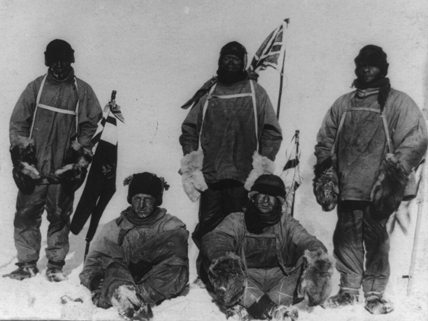Robert F. Scott (bottom left) and members of the British Terra Nova expedition, South Pole, 1912
One century has passed since Roald Amundsen’s polar expedition reached Antarctica and his team of five Norwegians became the first human beings to stand at the forbidding South Pole. The men and 11 dogs completed the journey on December 14, 1911. Word of their feat reached the outside world in early March 1912, but meanwhile a rival polar expedition learned of Amundsen’s accomplishment firsthand. The British explorer Robert Falcon Scott, accompanied by four men, arrived at the South Pole on January 18, 1912, just a month behind Amundsen—only to find a flag of Norway, the Norwegians’ abandoned tent, and a note “welcoming” the runner-up.
Reading about the efforts these men put forth and the conditions they endured to reach the South Pole one hundred years ago, one gets a glimpse of what has been called the Heroic Era. After sailing for four months from the Madeira Islands in the North Atlantic aboard the Fram (“forward” in Norwegian), they arrived at the Bay of Whales in Antarctica. From this natural ice harbor some 800 miles from the South Pole, Amundsen’s men hauled about 10 tons of supplies each day for three weeks over a distance of two miles inland to their base camp, using only sledges and dogs. From there, the expedition made preparations for the “dash to the Pole.” Over another three weeks, they forward-based more than 1.5 tons of supplies another 300 miles toward the Pole before hunkering down to endure an Antarctic winter. During the march to the Pole, the men endured temperatures of – 70 F—so cold the liquid in their compasses could freeze solid; climbed 10,000 feet up a glacier; and pushed on through driving snow, 35 mph winds, and thick fog.
The names of the great polar explorers Amundsen and Scott are joined in the name of the international scientific station in Antarctica that is their legacy. The station is engaged in astrophysical observations, climatological measurements, and other cutting-edge scientific endeavors.
Image Credit: Library of Congress Prints & Photographs Division
Related Links
-
This Day in History: Amundsen Reaches South Pole
History.com’s “This Day in History” feature for December 14 reports on Roald Amundsen’s chievement.
(Source: History.com; accessed January 31, 2012) -
Roald Amundsen (1872–1928)
Read this biography of the Norwegian who led the successful South Pole expedition a century ago.
(Source: south-pole.com; accessed January 31, 2012) -
Pictures of South Pole Expedition Goes Online
View these photographs of the Scott expedition newly released online.
(Source: BBC News, January 18, 2012) -
Amundsen-Scott South Pole Station
Check out the official website of the permanent international scientific station in Antarctica, named for the explorers who reached the South Pole a century ago; includes details on such projects as observation by the South Pole Telescope, one of the most powerful on Earth.
(Source: southpolestation.com; accessed January 31, 2012) -
Amundsen’s South Pole Expedition
This encyclopedia entry includes aspects of how history has remembered the events of 100 years ago.
(Source: Wikipedia.com; accessed January 31, 2012)





i like the south pole
me too
The question I’d rehtar ask is, “What if he’d made it back but was still second to Amundsen?” I’ve heard that the big controversy was that Amundsen ate his dogs — as the supplies were used, the sleds got lighter, fewer dogs were needed, ergo, why carry so much food? Scott used ponies and refused to eat them, which was very noble but we see the outcome. Had he succeeded, could he have achieved fame as “First Man To The South Pole Without Eating His Pack Animals”? Seems a bit of a stretch, doesn’t it?
That was very interesting info!
THAT WAS COOL.
Wow this is amazing, can you imagine the cold???
Its so fantastic what the explorers went through!!
The article really opened my eyes to the south pole.
Note that the photo is incorrectly captioned. This is the British polar party, not Amundsen’s Norwegians.
Standing L to R: Lawrence Oates, Robert Scott, Edgar Evans
Sitting L to R: Henry Bowers, Edward Wilson
Note that it is a British flag in back of Scott, not a Norwegian flag.
Thanks, Ron. You’re right.